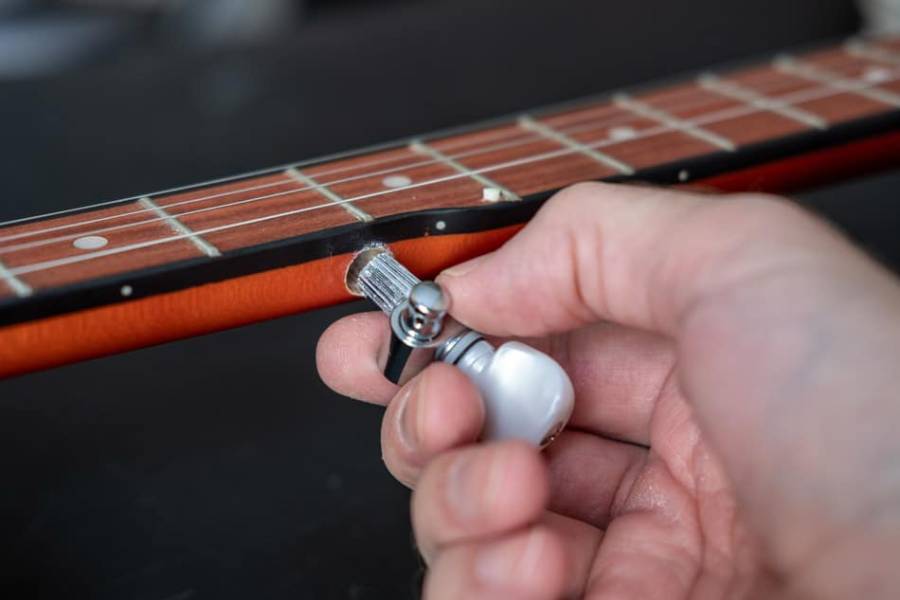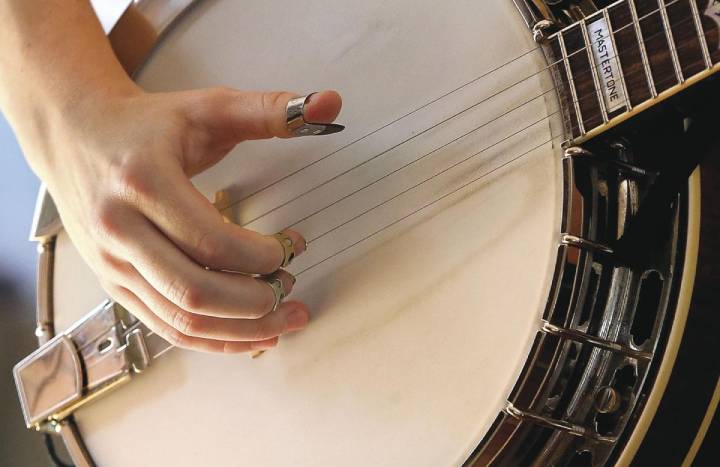
This is one of the most common doubts by all beginner banjo players: how and when to change the banjo strings. There is no definite timeframe for it as it entirely depends on factors such as how much the banjo has been played, the quality of the strings and how fast they deteriorate, other external factors such as climate, maintenance, cleaning.
Usually, the 4th string is the first one to wear out the fastest, and others gradually follow. So, when you notice that the 4th string begins to lose sustain and volume and won’t just stay in tune properly, it is perhaps time to restring your banjo.
Alternatively, an easy way to tell if the strings need to be changed is to run your fingers down them. If they feel smooth and silky, then you are good to go. But if the strings feel rough or dirty, then it is certainly time to change them. By doing so, you can bring the tone of your banjo back to life.
There are only a few tools you need to change your strings (products listed below in this articles).
- A fresh pack of strings (obviously)
- A string winder
- A pair of good wire cutters
- A chromatic tuner
- A pencil
STEPS TO RESTRING YOUR BANJO
STEP 1: REMOVE THE OLD STRING
Remove the 1st string and unwind it to the tuning peg. After that, you can remove the string from the tailpiece. Remember that whenever you are restringing a banjo, you can change only one string at a time to save yourself some readjustments by keeping them for later.
STEP 2: INSERT A NEW STRING
Through the tailpiece, attach the new string by holding it with some tension in order to keep it attached to the tailpiece.

STEP 3: HOOK THE LOOP END OF THE STRING ON THE BRIDGE
First, make sure that the loop fits over the hook on the tailpiece. If you need to make the loop wider or bendy, just stick a pencil through it and roll the loop around. Then simply slip the loop end over the hook and run the string to the bridge or tailpiece.
Step 4: Reposition the bridges
Banjos have movable bridges, so while removing the strings, bridges may also come off. You can adjust the bridge by playing the harmonic of the 1st string at the 12th fret and then you can compare it to the fretted note. If the fretted note is sharper, you need to move the bridge toward the tailpiece. If you find the fretted note flat, then you need to move the bridge towards the neck.
Important tip: For this step, you should use your right hand to reach over and grasp the string at the 5th fret. Then pull the string up by keeping it between your index and middle fingers. Make sure you let the string slide through your left fingers.
STEP 5: PUT THE STRING THROUGH THE TUNER AND BEGIN TUNING
Once the string is secured to the tailpiece, you can pass it through the hole on the tuner post. With one hand, hold a little slack on the string, and with the other, hold the peg. Now, slowly bring the free end of the string towards the pegs and put it between them, and then go around the post and underneath the string. Then pull the free end back over to the string and wind the string on the peg. After this, tune the string to pitch, and then just cut off the excess string.
Once you fit the other strings using the same method as the 1st string, tune it to pitch, and you are good to go.
WHY YOU SHOULD CHANGE THE STRINGS
The benefits of keeping your strings fresh are countless. It improves tone quality, provides better right and left-hand finger response, and opens a wider range of dynamics possible. Changing the strings also create more range of tones. An added bonus is that your banjo not only looks and but also feels better.
IMPORTANT TIPS regarding HOW TO RESTRING A BANJO

CONCLUSION
To sum up, restringing a banjo is a really simple task. With time and practice, changing the strings will become your habit. In order to add longevity to your banjo, Keep your instrument covered, clean it regularly and oil the strings and tune it often. When you take good care of your banjo on a regular basis, it ensures less chance of the strings wearing down.
things you'll need
1. A Fresh Pack Of Strings
2. A STRING WINDER:
3. A pair of good wire cutters
4. A chromatic tuner

Gibson is a blogger and reviewer, whose passion is helping people with all the aspects of music through the blog he provides. Also, he is an artist and loves to create his own tunes by purchasing good quality musical tools. With his own experience, he has provided a great list of tools for you in this blog. Seeking the best quality musical tools? Read this blog and end your music thirst!











